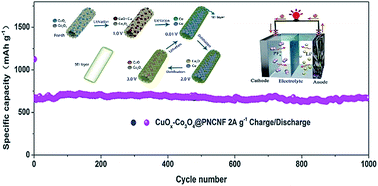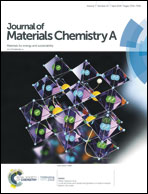Hierarchical CuOx–Co3O4 heterostructure nanowires decorated on 3D porous nitrogen-doped carbon nanofibers as flexible and free-standing anodes for high-performance lithium-ion batteries†
Abstract
CuOx–Co3O4 heterostructure arrays are grown on 3D porous nitrogen-doped carbon nanofiber (PNCNF) substrates by electrospinning and solvothermal methods. When the CuOx–Co3O4@PNCNF composite is employed as a free-standing anode for lithium-ion batteries, it exhibits discharge capacity of 1122 mA h g−1 at current density of 200 mA g−1 after 100 cycles; the reversible capacity is 668 mA h g−1 after long-term 1000 cycles even at a high current density of 2 A g−1. This outstanding performance can be attributed to the rational design of the electrode structure and the fascinating synergetic contributions from the CuOx–Co3O4 heterostructure in addition to the 3D substrate, which can shorten the Li+ diffusion path, expand interfacial contact, and provide increased electrochemically active sites for lithium storage. The reaction mechanisms are investigated by ex situ XPS and FESEM, confirming the phase transformation of CuOx–Co3O4 and verifying the structural stability during cycling. This work not only proposes a high-performance lithium-ion anode, but also provides ideas to design and reveal the reaction mechanisms of other metal-oxide heterostructures for use in various energy storage materials.



 Please wait while we load your content...
Please wait while we load your content...